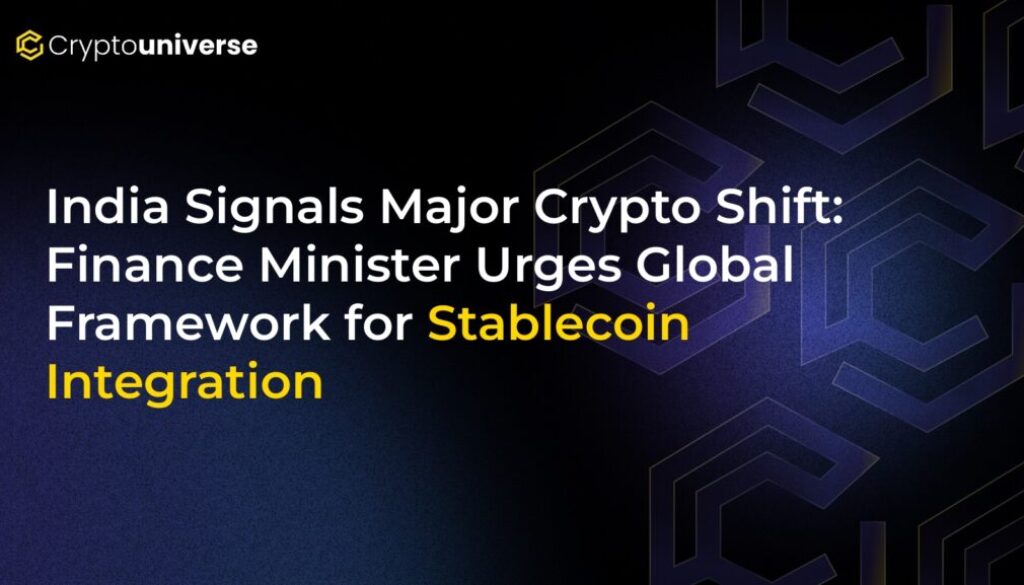India Signals Major Crypto Shift: Finance Minister Urges Global Framework for Stablecoin Integration

A New Chapter for Crypto in India? Finance Minister Calls for Stablecoin Preparedness
In a significant shift of tone from one of the world’s largest economies, India’s Finance Minister, Nirmala Sitharaman, has called upon nations to proactively prepare for the integration of stablecoins into the global financial system. This move signals a potential pivot from India’s historically cautious stance on digital assets, moving the conversation from outright bans to strategic regulation and adoption.
Speaking on the future of finance, Sitharaman highlighted both the immense potential and the inherent challenges that come with stablecoins. Her comments suggest that India is looking beyond the speculative nature of many cryptocurrencies and focusing on the utility-driven aspects of blockchain technology. This development is a crucial one to watch for investors, developers, and policymakers worldwide.
First, What Exactly Are Stablecoins?
For those new to the space, stablecoins are a class of cryptocurrency designed to maintain a stable value. Unlike volatile assets like Bitcoin or Ethereum, they are typically pegged to a real-world asset, most commonly a fiat currency like the U.S. Dollar.
- Fiat-Collateralized: Backed 1:1 by reserves of a currency like the USD (e.g., USDC, USDT).
- Crypto-Collateralized: Backed by a basket of other cryptocurrencies.
- Algorithmic: Use complex algorithms to manage supply and maintain their price peg, though this model has faced significant scrutiny.
Their primary purpose is to act as a stable bridge between the traditional financial world and the decentralized crypto ecosystem, enabling seamless transactions without the risk of price volatility.
The Potential Benefits Fueling India’s Interest
The Finance Minister’s call for preparedness around India Signals Major Crypto Shift: Finance Minister Urges Global Framework for
1. Revolutionizing Remittances: India is the world’s largest recipient of remittances. Stablecoins could drastically reduce the fees and settlement times associated with cross-border payments, putting more money directly into the hands of families.
2. Enhancing Financial Inclusion: A significant portion of India’s population remains underbanked. Stablecoins, accessible via a smartphone, could provide access to digital financial services, bypassing traditional banking infrastructure.
3. Fostering Innovation: A clear regulatory framework for stablecoins could unlock a wave of innovation in fintech, decentralized finance (DeFi), and Web3, allowing Indian developers and entrepreneurs to build for the global stage.
Navigating the Challenges and Risks
While optimistic, Minister Sitharaman was also pragmatic about the hurdles that lie ahead. Integrating stablecoins into a financial system as vast as India’s is not without significant challenges that require careful consideration.
Monetary Sovereignty: The widespread adoption of a foreign currency-pegged stablecoin (like a digital dollar) could pose a risk to the authority of the Indian Rupee and the nation’s monetary policy.
Regulatory Clarity: Creating a robust legal framework is paramount. Regulators must address issues like consumer protection, anti-money laundering (AML) protocols, and the operational standards for stablecoin issuers.
Systemic Risk: The collapse of a major stablecoin could have cascading effects on the financial system. Ensuring that stablecoin reserves are transparent, audited, and secure is a non-negotiable prerequisite for safe integration.
What This Means for the Future
Nirmala Sitharaman’s statement is more than just a comment; it’s a strategic signal. It indicates that India is moving towards a more nuanced and sophisticated approach to digital assets. Rather than a blanket ban, the focus is shifting towards harnessing the technology’s benefits while mitigating its risks through thoughtful, globally-coordinated regulation.
As India continues to leverage its G20 presidency to shape global crypto policy, this call for stablecoin preparedness could be the first step towards establishing the country as a key player in the future of digital finance. The path forward will likely be cautious and deliberate, but the direction seems to be set towards integration, not isolation.


